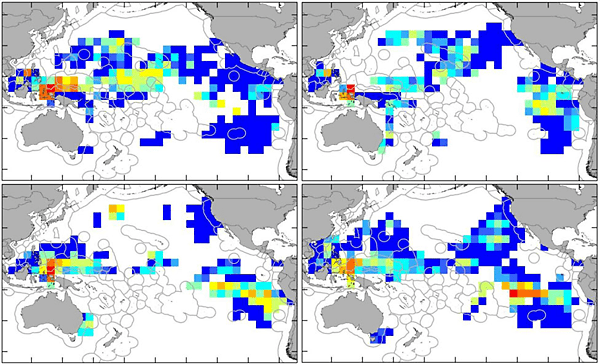GPS Traffic Maps for Leatherback Turtles Show Hotspots to Prevent Accidental Fishing Deaths

- Drexel Selects New, World-Class Life Sciences Building at 3201 Cuthbert Street for Medical Research Operations
- Breakthrough on Gene Therapy for Hereditary Spastic Paraplegia
- Drexel Environmental Collaboratory Releases Cross-Sector Findings on Severe Weather Recovery Challenges
- Drexel Launches the Manuel Stamatakis Center for Alternative Investments at the LeBow College of Business

The leatherback turtle in the Pacific Ocean is one of the most endangered animals in the world. Its population has declined by more than 90 percent since 1980. One of the greatest sources of mortality is industrial longlines that set thousands of hooks in the ocean to catch fish, but sometimes catch sea turtles as well. Using modern GPS technology, researchers are now able to predict where fisheries and turtles will interact and to reduce the unwanted capture of turtles by fishermen.
In a new study in the Proceedings of the Royal Society B, researchers show the use-intensity distributions for 135 satellite-tracked adult turtles and distributions of longline fishing effort in the Pacific Ocean. The overlap of these distributions in space and time allows prediction of bycatch risk. The researchers argue that time and area closures for the fisheries are essential to protect these animals as well as to maintain the health of the commercial fishery.
The research was conducted by a team from Drexel University, several other universities, the NOAA/NMFS Southwest Fisheries Science Center and a U.S. non-profit, The Leatherback Trust. The study was supported by the Lenfest Ocean Program.
“Given the size of the Pacific Ocean and the number of fisheries from dozens of nations that use it, managing bycatch is a complex issue,” said John Roe, PhD, lead author of the paper and an assistant professor at the University of North Carolina at Pembroke. “To complicate things, fisheries authorities are not always forthcoming with information on when and where they capture turtles, so identifying problem areas, or hotspots, where bycatch likely occurs has proven elusive until now”.
“Given the size of the Pacific Ocean and the number of fisheries from dozens of nations that use it, managing bycatch is a complex issue,” said John Roe, PhD, lead author of the paper and an assistant professor at the University of North Carolina at Pembroke. “To complicate things, fisheries authorities are not always forthcoming with information on when and where they capture turtles, so identifying problem areas, or hotspots, where bycatch likely occurs has proven elusive until now”.
Spotila, a co-author of the study, has been studying sea turtles with colleagues and Drexel students, for 25 years.
The researchers also found that areas of predicted bycatch risk did not overlap for eastern and western Pacific nesting populations of leatherback turtles – indicating these populations should be treated as distinct management units with respect to fishing bycatch.
For western Pacific populations there are key areas of high risk in the north and central Pacific ocean, but the greatest risk is adjacent to the nesting beaches in tropical seas of Indo-pacific islands such as Papua New Guinea and Irian Jaya and the Solomon Islands. These areas are under the exclusive economic control of national authorities and can readily be regulated.
“Bycatch may be more easily avoided when areas of high risk occur predictably in space and time, allowing fisheries operators to adjust their efforts accordingly”, said Roe. “Because leatherbacks follow paths that persist from year to year as they revisit the same nesting beaches, these areas provide an especially good opportunity for flexible regulations that serve the needs of both turtles and fisheries alike.”
For eastern Pacific nesting populations, there is moderate risk associated with migrations to nesting beaches, but a large and persistent risk is in the South Pacific Gyre, a broad open ocean area outside national waters. Management is currently lacking for this area and may be difficult to implement.
The authors recommend that efforts should focus on these predicted hotspots to develop more targeted management approaches to alleviate leatherback bycatch.
“Now that we’ve scientifically homed in on where and when protections are needed, especially in the South Pacific Ocean the solutions to the turtle fishery problem will take international cooperation and innovative uses of technology to manage this wild west where regulations are few and enforcement is nil,” Spotila said.
In This Article
Contact
Drexel News is produced by
University Marketing and Communications.